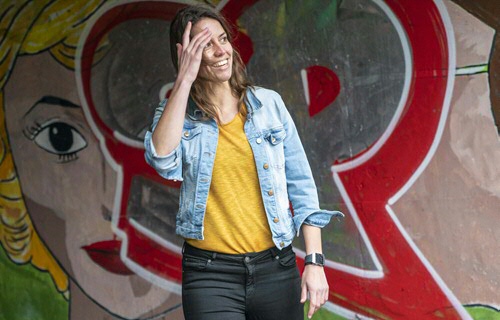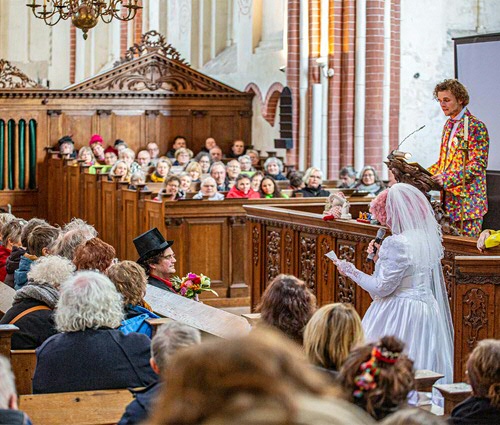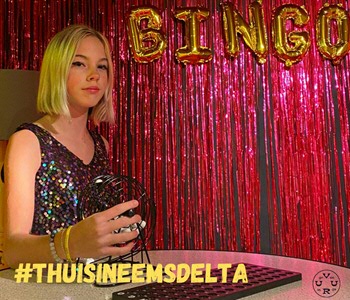Culture as energy for the future
The population of the province of Groningen is shrinking faster than any other region in the Netherlands. For many years, people have been leaving the northern countryside behind, which has major consequences for the quality of life in villages. What can be done to preserve and even strengthen the resilience of those villages? It is precisely this question that Gwenda van de Vaart, assistant professor at the Faculty of Spatial Sciences, is trying to answer.
Text: Merel Weijer, Communication UG
A Groninger in Pingjum
Van der Vaart is a true native of Groningen; she was born at the UMCG and raised in Grootegast in the Westerkwartier. She feels connected to the Groningen countryside. After secondary school, she went on to study at the University of Groningen, where she also did her PhD. Her doctoral thesis focused on a participatory research project in Pingjum, a well-known artsy village in Friesland. Compared to other villages in the Netherlands in general, and the northern Netherlands in particular, it is home to a relatively large number of artists and creative people and many cultural activities are organized there. Van der Vaart investigated the impact that this can have on a village’s resilience.

Community art
One of her conclusions was that art can increase ‘social capital’: it can help make people feel more connected to one another; it brings people together and makes them think about their environment. And, ultimately, this increases an area’s or a village’s resilience. Community art projects, in which artists work alongside the inhabitants of a town or village, are particularly effective at achieving this. The Grutte Pier project, organized by PeerGrouP (a local theatre company) in Kimswerd, is a prime example. PeerGrouP spent several years collaborating with local residents to produce a theatrical trilogy about the Frisian freedom fighter, Grutte Pier. Van der Vaart: ‘The village was enraptured by this project for quite a long time. Once it came to an end, people were very positive about the effect it had had on the village. It created a sense of community because everyone pulled together to work on one thing. And because it was a success, people gained confidence in their own abilities.’

Gronings Vuur
Van der Vaart is currently involved in a similar, large-scale project in the province of Groningen, Gronings Vuur, which also brings together art professionals, amateurs and villagers. The project was commissioned by the province of Groningen to strengthen the cultural infrastructure. To date, much of the attention has been focused on the city, to the detriment of the Ommeland (the province). This needs to change. For the last year and a half, the project has toured various municipalities with its cultural programme. Gronings Vuur has shone light on events and developments in the province through music, photography, film, poems, conversations and art. Each municipality concluded the project with a final presentation, for example a theatre play or an exhibition. The municipality of Oldambt even organized a fictitious wedding. The final evaluation will be taking place in February during the ‘Open Space’ finale event. Van der Vaart will also present her findings during the event.
Reflection on the future
Van der Vaart is using questionnaires to survey cultural players who were involved in the project locally, visitors to the final presentations and members of the local cultural community who did not participate in the project. She is also interviewing cultural representatives from the municipalities and cultural players involved in the entire project, such as VRIJDAG and De Rijdende Popschool. This approach ultimately allows her to assess the two objectives of the project; to strengthen the cultural infrastructure and to facilitate the discussion of themes that are relevant to each specific municipality. She is also reflecting on what people want to see happing in the future regarding art and culture as a result of the project.
Working towards something, together
She can already see that the project is clearly having a positive impact. ‘People involved in the project have said that the process of working together to achieve something is incredibly valuable. It strengthens existing connections or creates new, sometimes very surprising, connections.’ People also appreciate the fact that relevant themes are put in the spotlight. Some of the subjects covered include ‘What feels like home?’ and ‘Dealing with others’ (for example, newcomers). Van der Vaart knows from her PhD research that if people feel more connected, they are more likely to get involved in their village or community. The Gronings Vuur project has also helped people to think about what needs to change in the future – and how.

At home in Eemsdelta
The project has now reached what will become the new municipality of Eemsdelta on 1 January. This part of the research has been given the title #thuisineemsdelta. Residents could donate objects that are symbolic of what makes them feel at home. And this could be anything – from a piece of furniture, a song or a recipe to a photo, a story or a view. Artists then used three objects to create a new work of art. These creations will be exhibited in a local café in Delfzijl and were given away as prizes during the recent online Eemsdelta bingo game.
New and positive energy
One thing is for certain; this project will not be dying a quiet death at the end of February. The Province has declared in its implementation programme for 2021-2024, ‘We are culture’, that it will continue to focus on improving the region’s organizational capacity. This provides room and hope for change. Not only to expand the cultural infrastructure, which will certainly benefit the Ommeland, but also to strengthen it. This will help to improve community resilience, which, in turn, will be a source of new and positive energy for the future. Something that the shrinking northern province definitely needs.
More information
| Last modified: | 24 December 2021 2.42 p.m. |
More news
-
08 May 2024
Juliette de Wit, Femke Cnossen and Maite Laméris receive YAG grant
Juliette de Wit, Femke Cnossen and Maite Laméris have received a YAG Grant of € 6,000 for an interdisciplinary project on the long-lasting socio-economic consequences of the ‘Arbeitseinsatz’ in the Netherlands. The grant enables them to explore...
-
23 April 2024
From battling against the water to living with the water
Margo van den Brink, associate professor of Water and Planning, says that we should adapt our spatial design to the changing climate. This implies difficult choices have to be made because the space is limited and the needs are great.
-
16 April 2024
Investors consider region a risk
Investment in real estate appears to be an important explanation for the gap between big cities and the region, argues Michiel Daams, associate professor of Economic Geography of the Real Estate Market. He conducted research on investments in the...
